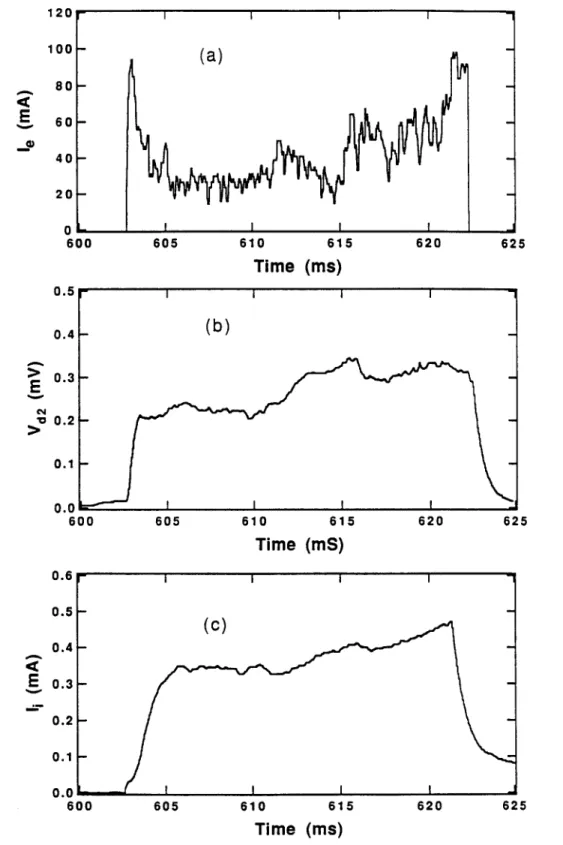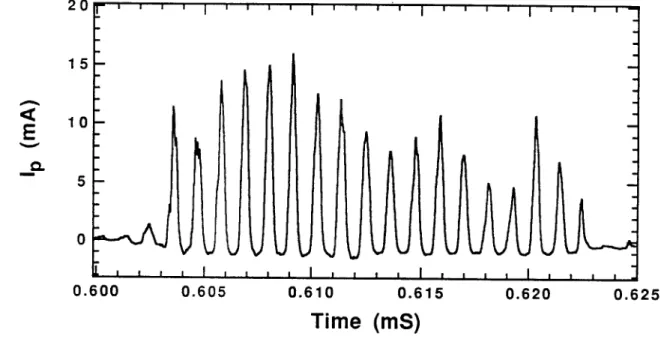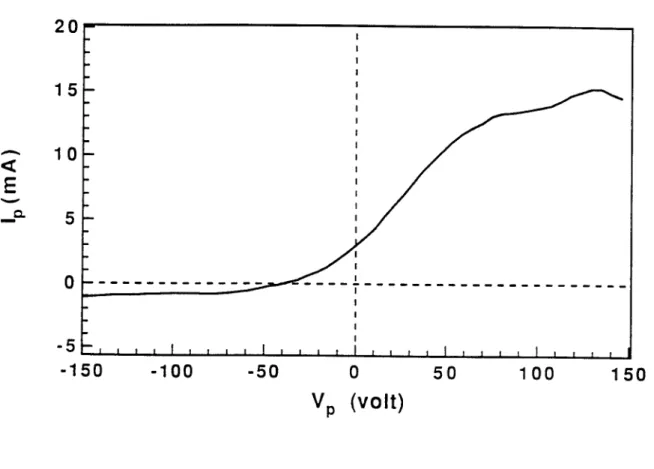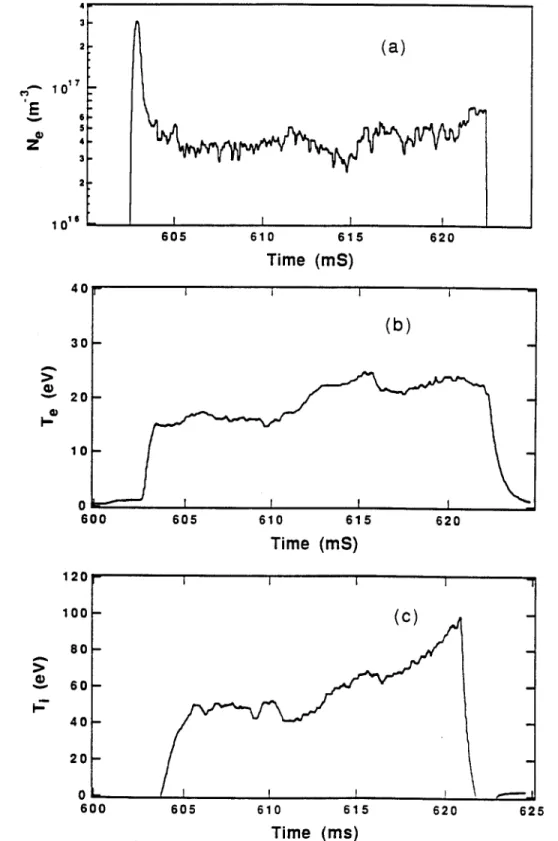PFC/JA-94-23
Determination of Ion Temperature with Single and Triple Langmuir Probes
T. F. Yang, Ping Liut and
Q.
X. ZutPlasma Fusion Center
Massachusetts Institute of Technology Cambridge, MA 02139
Submitted to the Review of Scientiflc Instruments August 25, 1994
This work was supported by NASA under Contract #NAS-9-18372, NASA/JPL under Contract #958265, AFOSR under Contract #AFOSR-89-0345, and DOE under grant #DE-FC02-93-ER-54186. Reproduction, translation, publication, use, and disposal, in whole or in part, by or for the US Government is permit-ted.
t
Southwestern Institute of Physics, Chengdu, Sichuan, ChinaDetermination of Ion Temperature with Single and Triple Langmuir Probes
T. F. Yang, Ping Liut and
Q. X. Zu:
Plasma Fusion CenterMassachusetts Institute of Technology Cambridge, Massachusetts 02139
Abstract
This work discusses a method of determining plasma Ion Temperature using a single and a triple Langmuir probe in a plasma system having a finite ion temperature. The triple probe measures the plasma potential difference between a pair of the floating probes and ion saturation current, Ji , from another pair. The single probe is biased at a positive voltage higher than the space potential
(
corresponding to the bend in the I-V characteristic curve ) where the electron current approaches a saturation value. It measures the electron saturation current, Je . The electron temperature, T, , is determined by the plasma potential difference from the triple probe. However, instead of determining the electron density, ne , from the relation Ji = exp (-1/2)en, /k Te/mi and T by neglecting Ti , it is now obtained from J, . It is not needed to make the zero ion temperature assumption which is no longer valid when the ion temperature is finite or higher than the electron temperature. Taking ne and Te , the ion temperature can now be calculated from the relationship Ti = (m2/k)(Ji exp (1/2)/ene)2 - T,.t
Southwestern Institute of Physics, Chengdu, Sichuan, China t Institute of Physics, Chinese Academy of Sciences, Beijing, ChinaI. Introduction
In many plasma systems it is important to be able to measure the ion temperature. There are several techniques which have been used successfully in fusion plasma systems and few other systems. However, they are either applicable only in a high temperature regime, too complicated and costly and/or have other limitations. It is desirable to develop
a technique more suitable in the low temperature regime for small scale laboratories and low budget experiments. In a high temperature plasma system like the fusion energy devices the ion temperature has been successfully determined by the charge exchange method1. The charge exchange method is not practical for a small scale laboratory because of its complexity as well as the high capital and operational costs. It is difficult to make a spatial scan. Furthermore the method is not suitable for measuring low ion temperature (below 10 eV). The grid energy analyzer has been proven useful', but the perturbation of the large probe head on the plasma is not known and is very difficult to determine. The plasma temperature is determined by fitting the data to a Maxwellian distribution function, and careful post analysis is required to obtain the results. The uncertainty is large when the ion temperature is low ( less than 10 eV ). Fine spatial scanning is not practical for a small plasma system because of the large probe head. The Doppler broadening method1 with the use of a spectrometer has been tried. It requires a high resolution spectrometer and frequency scanning system. Optical alignment is critical and spatial scanning is limited
by the optical path. The ion temperature of a hydrogen plasma can only be measured
indirectly through seeding the plasma with helium or other species. Every method has its own merit, purpose, advantages and limitations. It would be nice if one could put all these diagnostics on the system so that the plasma properties can be monitored in every aspect. Therefore it is the purpose of this work to examine the possibility of ion temperature measurement by a very simple method: the use of Langmuir probes. It will provide a low cost, convenient and flexible alternative diagnostics if it is found to be feasible.
In the analysis of the Langmuir probe current signal, the electron temperature is determined from the slope of the I-V curve1'4. The density is calculated from the ion
saturation current neglecting Ti based on the assumption that the ion temperature is very low or much lower than electron temperature. This assumption came from the very low temperature and low density plasma4 and was used as a convenience to obtain the electron
density. This is no longer true in high temperature plasma, such as a tokamak or mirror device, where the ion temperature could be higher than that of the electrons when the plasma ions are heated by rf power or neutral beams. Even in a low temperature plasma, the ion temperature could be significant and should not be ignored.
A triple Langmuir probe measures the plasma potential difference between a pair of the
probes and ion saturation current from another pair. Both pairs share one common probe. Here again the ion temperature is ignored in order to obtain the electron density from the ion saturation current. We propose to obtain the electron density from the electron saturation current of a single Langmuir probe biased at a potential higher than the space potential where the electron current approaches saturation. Therefore the ion saturation current can now be used to calculate the ion temperature. There are new uncertainties, such as the error in measurement of the electron saturation current at a fixed probe voltage. However, we gain the accuracy by removing the zero ion temperature assumption.
During the course of this study, we have encountered a great deal of difficulty in the measurement of Triple probe. Section II is devoted to the discussion of the construction of the triple probe and its circuit. Section III discusses the ion temperature measurement.
II. Triple Probe Measurement
Many work, related to Triple Langmuir method, have been previously reported"'6,'7 . However, to use the probe successfully in an experiment still takes a lot of trial and error. The learning curve involved is painfully frustrating and time consuming. Principally, all
the electrodes in the probe have to be completely floated and have to be isolated from the data acquisition system. It is absolutely important that every possible local loop has to be eliminated or minimized. All conducting material has to be shielded from the plasma except probe tips; otherwise one will obtain false reading or random readings with large pick-ups. After a painstaking work, a dependable probe has been obtained. The detailed probe configuration and experimental setup are described below.
Figure 1 presents the configuration of the probe, vacuum feedthrough and cabling. The probe assembly consists of three 0.5 mm tungsten wires. The probe tips are 3 mm in length. Each wire is insulated by ceramic tubing and then shielded by stainless tubing. The probe wire, ceramic insulator and stainless steel form a coaxial cable. It would be better to insert this solid coaxial cable into another ceramic tubing to isolate the stainless outside shield from the plasma. This will greatly increase the over radius of the coaxial tubings and thus the space between the probes. This will make the probe assembly undesirably large. To minimize the separation between the probe tips and the overall size of the probe assembly, we gave up the idea of further insulating every probe tubing individually. The stainless steel tubings were spot welded together, making certain of good contact lengthwise such that local loops were negligibly small. The three probe cable assembly is then enclosed in a quartz glass tube leaving only the probe tips extruding into the plasma. This prevents the stainless shielding from acting like a floating probe. The probes are isolated from the shaft by a ceramic feedthrough which has four pin conductors. The stainless shielding tubings are then eclectically connected to the fourth conductor through an insulated wire grounded at the case of a junction box on the far end of the shaft.
The probe wires through the shaft connected to the load resistors must be individually shielded and the shielding itself must also be eclectically isolated. The pair of current carrying wires should be twisted together. The probe shaft is isolated from the plasma chamber at the entry port. The entry port has a KF-40 flange. The flange clamp and
O-ring are made of insulator.
The electric connections are made in the junction box at the end of the shaft. All the connectors on the junction box and inputs to the amplifier should be isolated. Importantly, the power supply has to be floating and the ground pin on the wall plug should not be used. We use battery packs instead of regular power supply. The physical ground is made at the junction box.
The experiment was carried out on an axisymmetric tandem mirror device which was built at the MIT Plasma Fusion Center for space plasma propulsion study8,9,10. The simplified experimental setup is shown in Figure 2. The plasma discharge was obtained by back filling the chamber to 8 x 10-5 torr of hydrogen which was broken down with microwave power of 500 W at 2.45 GHz. It was further heated with an rf power of 10 kW at 3 MHz and at a pulse length of 20 ms. The triple probe and a Langmuir probe were mounted on the midplane of the device at the same radial position but 180 degrees apart, angularly. Their radial position is 5 cm which is one half of the plasma radius. Since the triple probe is in a strong axial magnetic field, we were concerned that the measurement might be affected by the direction and intensity of the magnetic field due to the fact that there are three probe tips used to measure two different quantities, the ion saturation current and the plasma potential difference. To examine this concern a study has been made by rotating the probe and moving the probe axially to a stronger and nonuniform field region close to the magnetic mirror point. No distinguishable difference has been observed beyond the expected uncertainties due to fluctuations, spatial variations and irreproducible effects between shots. We can say that to the first order the effect of magnetic field direction, intensity and uniformity on the triple probe due to its asymmetric structure is not a concern.
The experimental results are presented in Figure 3. Figure 3a is the electron saturation current taken with the single langmuir probe. The plasma potential difference and the ion
current signals taken with the triple probe are shown in Figures 3b and c respectively. The analysis is discussed in the next section.
III. Ion Temperature Calculation
The theory of a triple probe has been fully developed56,'7. We briefly review the method and formulation of a symmetrical triple probe discussed by Chen and Sekiguchi5
in order to present our thinking and the changes to be made for electron density and ion temperature calculations. The current equations for the triple probe are following
-I= -SJ exp (-OV1) + Sji(V), (1)
I2 = -SJe exp (-OV2) + Sji(V2), (2)
13 = -SJe exp (-bV3) + Sji(V3), (3)
where
= e/kTe, (4)
and
J= n~e kTe/27rme . (5)
Here Je and Ji are the electron and ion saturation current density respectively, S the surface area of the probe tips, k the Boltzmann constant, and e and m, the charge and mass of an electron, respectively.
By assuming the relationships ji(Vi) = ji(V2) = Ji(V3)(= Jj) and eliminating SJ,
one obtains the following equations,
1, +12 1 - exp (-d2) (6) 1, +13 1 - exp (-OVd3)' and 1 13 - 12 exp (- OVVd) (7) S 1 - exp (-OVVd)
where V2 = V2 - V1, Vd3= V3- V and
VVd = Vd3 -Vd2 = V3 -V 2 (8)
Equation (6) determines the value of T directly. The common practice is to use the equation
Ji ; Jis = exp (-1/2)ene /k Te /Mi. (9) to determine electron density, ne . An assumption of T
<<
T has been made in equation9. This assumption is not universally correct. In many plasma systems, particularly in fusion energy devices, the opposite relation T
>>
T, exists. It is in fact our preferred condition for plasma propulsion. Therefore it is logical and more accurate to preserve the ion temperature term in the ion saturation current relationshipJi e Jis = exp (-1/2)en, y/k(Te + T2)/Mi, (10)
Thus T can be determined using the electron density, n, , obtained from equation (5) and the electron saturation current measured with the single Langmuir probe. By forcing probe P2 to be at floating potential and setting Vd3 at a very large value, equation (6) is reduced to a very simple equation
exp (-Vd2) = 1/2. (11)
As is mentioned previously the electron saturation current was obtained by setting probe at a biased voltage of 150 V. This voltage was predetermined from the I-V characteristic curves by sweeping the applied probe voltage. The current signal taken by a DCM Langmuir probe"' is shown in Figure 4. The voltage is swept from -150 V to +150 V at a frequency of 1000 Hz. Each peak contains one cycle and gives two I-V curves. A typical I-V curve is shown in Figure 5. The electron saturation current is normally taken to be the value at the bend. The voltage at this point is 80 V , the plasma space potential. These space potentials vary from 50 to 120 volts from the examination of all the I-V curves for the
time scan of the probe signals. In reality the electron current continues to rise slowly and approaches constant value asymptotically. Here we pick 150 V as the probe bias voltage to assure that the probe measures saturation current for the entire time scan. The maximum error is I(150) - Ie(50) which amounts to less than 10%. This is much less than the error
made from the assumption that Ti = 0, which can be as high as 35% when Ti = T, '.
The deduced electron density would be rendered useless if Ti became larger than T. The equations used for the determination of Te, n, and Ti are collected and listed as follows,
kTe = exp (-1/2)Vd2, (11)
and
J ee efk Te/27rme, (5)
and
Ji ~ Jis = exp (--1/2)ene /k(Te + T )/mi. (10)
The time scans of the ne, T and Ti are plotted in Figure 6. It is seen that Ti is much larger than T, and most of the time the ratio of these two values is more than doubled or tripled. Ignoring Ti in the ion saturation current would miss a very important part of the plasma parameters as well as provide an incorrect value of electron density. One might argue that the probe crossection should include the sheath thickness. Such correction to the probe crossection is needed if the probe is spherical and is in a nonmagnetized plasma. The triple probe is in strongly magnetized plasma and the tips are cylindrical; the projected current collection area does not change due to presence of the sheath potential.
A comparison of the errors risen from the traditional method and the current method
is in order. In the traditional method using equation (9) to calculate n, , the error would increases as the ion temperature increases. For example the errors would increase from 44% to 100% when Ti increases from T to 3T . These errors increase the value of the
value could be more than doubled. Therefore the traditional method would underestimate the n, value which can be more than a factor of two too small. The error related to the current method is the uncertainty for obtaining the density n, from equation (6). The uncertainty in the measurement of the electron saturation current is about ±10%. However, the ion temperature is inversely proportional to the square of the density, the uncertainty in Ti is twice the negative value of the uncertainty of ne, i.e., :-2 0%. The error is physically more meaningful.
IV. Concluding Discussion
This work demonstrates the technique to determine the ion temperature using a single and a triple Langmuir probe. It provides a valuable plasma parameter, Ti . The uncer-tainty seems better than the usual technique in determining the ne from Ji by neglecting the ion temperature Ti . This probe set has the advantage of being small in size, low cost and simple to fabricate and operate. The results can be displayed almost immediately. Therefore high time resolution measurements of the plasma parameters can be obtained. The error associated with this method seems to be reasonable in value and in physical meaning. The single and triple probes can be combined to form a quadruple probe so that the measurements can be made at the same spatial location. Great care has to be taken to avoid the arcing between probe tips when high voltage is applied to the probe.
Acknowledgement
This work is jointly supported by US AFOSR and NASA/JPL and DOE. Valuable discussions with X. Z. Yao and the technical support of Harvey Lander are acknowledged.
References
1. I.H. Hutchinson, "Principles of Plasma Diagnostics", Cambridge University Press, New York,1st Ed. (1987)
2 T.F. Yang, A.S. Wan and G.S. Luan, J. Nucl. Mater.,172,220(1990)
3 A.S. Wan, T.F. Yang, B. Lipschultz, and B. LaBombard, Rev. Sci. Instrum. 57(8),1542(1986)
4. O.E. Johnson and L. Malter, Phys. Rev.,80(1),58(1950).
5. Sin-Li Chen and T. Sekiguchi, J. Appl. Phys.,36 (8),2363(1965)
6. M. Kamitsuma, Sin-Li Chen and Jen-Shih Chang, J. Phys. D: Appl. Phys.,10,1065(1977).
7. H. Ji and H. Toyama and K. Yamagishi and S. Shinohara and S. Fujisawa and K. Miyamoto, Rev. Sci. Instrum.,62(10), 2326 (1991)
8. F.R. Chang, W.A. Krueger and T.F. Yang", AIAA/DBLR/JSASS 18th Int. Electr. Propul. Conf.,paper AIAA-85-2049, Alexandria,Virginia(1985)
9. T.F. Yang and S. Peng and F.R. Chang-Dfaz", AIDAA/AIAA/DGLR/SASS 22nd Int. Electric Propul. Conf.,paper IEPC-91-129, Viareggio, Italy (1991).
10. T.F. Yang, and F.R. Chang-Diaz, MIT/PFC Report No. PFC/RR-94-1 (1994)
.~ s-i 4-
~:
-. C., s-i U *Z -W5-j
N7
5-C.) s-i $wC b.) 0 04 a0x
0 0 I0
Q
~0 0 * -bLJ=
=
0.0
Q
U, 0 U,I
mbJN
I
I
0
=
0
~0 0 -L z=
U, Cq~ 0120 100 80 60 40 20 01 60 610 615 620 625 Time (ms) 605 605 610 615 Time (mS) 610 615 Time (ms) 620 620 25 25
Figure 3. Time scans of electron saturation current measured by the single Langmuir probe(a), Potential difference V2 (b) and ion saturation current (b) measured by the triple probe.
605 E)
(a)
- -0 - (b)-0.5 0.4 0.3 0.2 0.1 E U.u . 600 E 0.6 0.5 0.4 0.3 0.2 0.1 0.0 600(C)
I I I-I I - --6 6I-I I I I I I I I
610 0.615
Time (mS)
0.620
Figure 4. Langmuir probe signal taken prior to the triple experiment for the purpose of determining the probe bias voltage.
20 15 10 5 0
E
I *I I I I I I I I I I -0.600 0.605 0. 0.62520 15 10
E
0 -5 50 -100 -50 0 50 VP(volt)
Figure 5. An I-V characteristic curve for the single probe.
S---100 150
605 610 615 620 Time (mS) OR (b) 610 615 Time (mS) 610 615 Time (ms) 620 620
Figure 6. Time scans of deduced electron density from electron saturation current mea-sured by the single Langmuir probe(a), ion temperature from the ion saturation current (b) and the electron temperature from the potential difference(c).
3 2 10 E z 4 3 2 is~1



